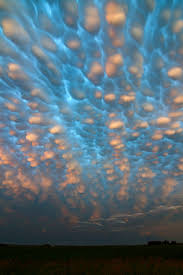Mammatus Clouds / Norii Mammatus
Formatiunile respective se numesc Mammatus si se formeaza cand norii sunt saturati cu picaturi de ploaie si/sau cristale de gheata
Mammatus, also known as mammatocumulus, meaning "Mammary cloud" or "Breast cloud" [1][2] is a meteorological term applied to a cellular pattern of pouches hanging underneath the base of a cloud. The name "mammatus" is derived from the Latin mamma (udder or breast), due to the clouds' characteristic shape, as some believe there is a resemblance between the shape of these clouds and the breast of a woman.
Desi absolut superbi, este foarte adevarat ca aparitia lor este de rau augur; norii mammatus prevestesc de cele mai multe ori aparitia unei furtuni sau fenomene meteorologice extreme. Sunt compusi in principal din particule de gheata, se extind pe sute de kilometri in orice directie, iar formatiuni individuale pot ramane vizibile static timp de 10-15 minute.
Mammatus may appear as smooth, ragged or lumpy lobes and may be opaque or semitransparent. Because mammatus occur as a grouping of lobes, the way they clump together can vary from an isolated cluster to a field of mamma that spread over hundreds of kilometers to being organized along a line, and may be composed of unequal or similarly-sized lobes.
The individual mammatus lobe average diameters of 1–3 km and lengths on average of 0.5 km. A lobe can last an average of 10 minutes, but a whole cluster of mamma can range from 15 minutes to a few hours. They usually are composed of ice, but also can be a mixture of ice and liquid water or be composed of almost entirely liquid water.
Desi absolut superbi, este foarte adevarat ca aparitia lor este de rau augur; norii mammatus prevestesc de cele mai multe ori aparitia unei furtuni sau fenomene meteorologice extreme. Sunt compusi in principal din particule de gheata, se extind pe sute de kilometri in orice directie, iar formatiuni individuale pot ramane vizibile static timp de 10-15 minute.
Mammatus may appear as smooth, ragged or lumpy lobes and may be opaque or semitransparent. Because mammatus occur as a grouping of lobes, the way they clump together can vary from an isolated cluster to a field of mamma that spread over hundreds of kilometers to being organized along a line, and may be composed of unequal or similarly-sized lobes.
The individual mammatus lobe average diameters of 1–3 km and lengths on average of 0.5 km. A lobe can last an average of 10 minutes, but a whole cluster of mamma can range from 15 minutes to a few hours. They usually are composed of ice, but also can be a mixture of ice and liquid water or be composed of almost entirely liquid water.
When occurring in tall, dense cumulonimbus clouds – or the anvil cloud stretching from them – mammatus often signal the onset of fierce storms and may warn of tornadoes. Tending to form in warmer months over the Midwest and eastern areas of the US, mammatus are nonetheless found elsewhere, as our chase across the States to track this singular meteorological phenomenon will reveal.

Connecticut
Georgia

Illinois

Iowa
Indiana
Kansas

Kentucky

Maine

Michigan

Missouri

Minnesota

Montana

Nebraska



Nevada



New Jersey



New Mexico


New York



Oklahoma


South Carolina



South Dakota


Texas


Utah


Washington


Wisconsin


Wyoming


Comentarii